From the Trenches
Seals of Approval
By MARLEY BROWN
Monday, February 12, 2018
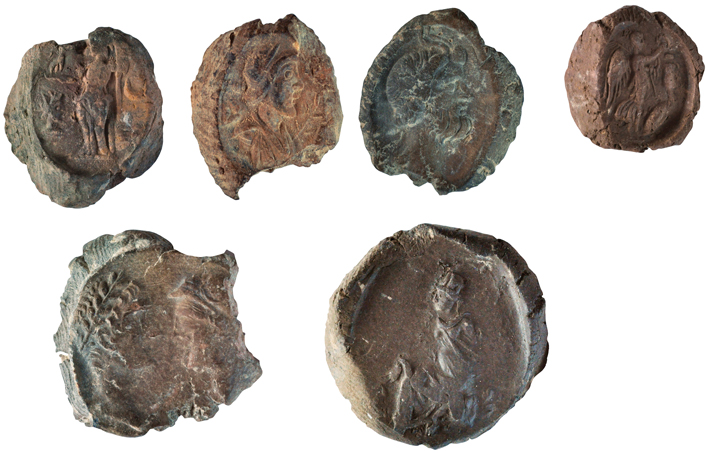
Archaeologists working in the ancient city of Doliche, now Dülük in modern-day Turkey, have uncovered a large collection of 1,800-year-old clay seals called bullae, which date to the period when the city was part of the Roman province of Syria. Many of the bullae appear to have been used for official government business and show various deities, including depictions of Roman emperors shaking hands with Jupiter Dolichenus, a thunder and war god indigenous to the area, whose cult spread across the Roman Empire in the second and third centuries A.D. “It is one of the great enigmas in the history of Roman religion that the main local god from a second-tier city of the north Syrian hinterland developed into one of the best attended cults of the empire,” says Michael Blömer, codirector of the University of Münster excavations. According to Blömer, “In one seal, the emperor is actually shown worshipping Jupiter Dolichenus. This close bond between a local deity and the emperor is a very peculiar motif and points to a special connection between Doliche and the imperial center.” This connection may partly explain how the god became so popular.
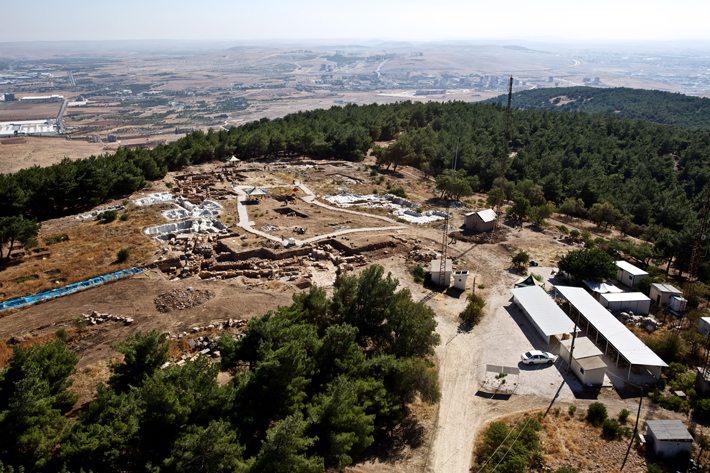
Head in the Sand
By MARLEY BROWN
Monday, February 12, 2018
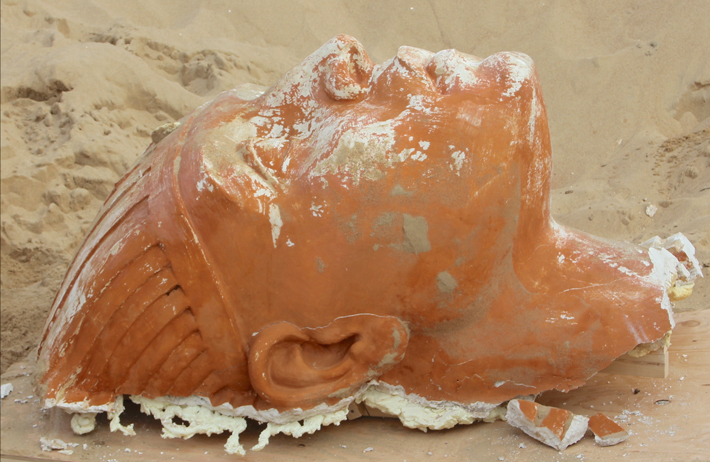
A piece of American cinematic history has been uncovered in California’s Guadalupe-Nipomo Dunes. Researchers have removed the head of a 13-foot-tall plaster sphinx built for Cecil B. DeMille’s 1923 silent film The Ten Commandments, one of 21 sphinxes designed by French artist Paul Iribe for a massive Egyptian Exodus set. Since the 1990s, efforts have been under way to find remains of the set, which DeMille deliberately buried to prevent other filmmakers from using it. According to Doug Jenzen, director of the Guadalupe-Nipomo Dunes Center, rapidly shifting sands will soon leave the remaining material vulnerable to disintegration, allowing little time to save evidence of a pivotal moment in U.S. popular culture. “These silent films were successful enough that the production companies were willing to experiment at great expense,” he says. “If they had tanked, perhaps we wouldn’t have Gone with the Wind and The Wizard of Oz. If these movies had flopped, we wouldn’t have the blockbuster films we have today.”
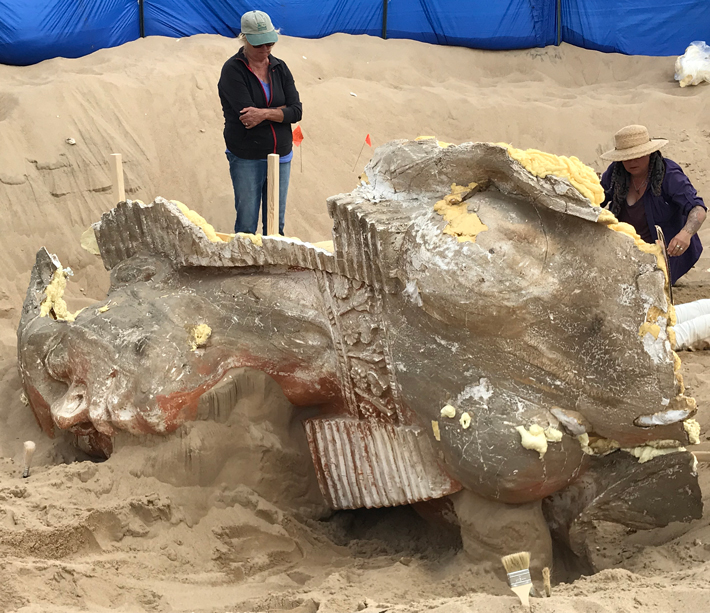
The Venus of Vlakno
By ZACH ZORICH
Monday, February 12, 2018
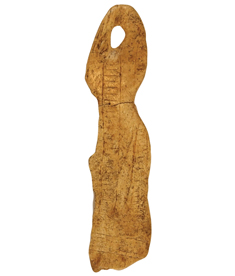 A 15,000-year-old bone pendant found at Vlakno Cave in Croatia may be a late type of Venus figurine, such as the famous Venus of Willendorf, which dates to more than 24,000 years ago. The Croatian Venus is a more slender and abstract human figure than the zaftig woman of Willendorf. The geometric pattern on the bone is similar to patterns found on other pieces of art from the Epigravettian period, during which sea levels were approximately 400 feet lower than they are now. What is today the northern Adriatic Sea was a broad plain that supported large herds of game animals hunted by the people at Vlakno. Other than the Venus pendant, however, no art produced by the Epigravettian people has turned up. Some perforated deer teeth and seashells are the only other symbolic artifacts found at the site.
A 15,000-year-old bone pendant found at Vlakno Cave in Croatia may be a late type of Venus figurine, such as the famous Venus of Willendorf, which dates to more than 24,000 years ago. The Croatian Venus is a more slender and abstract human figure than the zaftig woman of Willendorf. The geometric pattern on the bone is similar to patterns found on other pieces of art from the Epigravettian period, during which sea levels were approximately 400 feet lower than they are now. What is today the northern Adriatic Sea was a broad plain that supported large herds of game animals hunted by the people at Vlakno. Other than the Venus pendant, however, no art produced by the Epigravettian people has turned up. Some perforated deer teeth and seashells are the only other symbolic artifacts found at the site.
Caesar’s English Beachhead
By JASON URBANUS
Monday, February 12, 2018
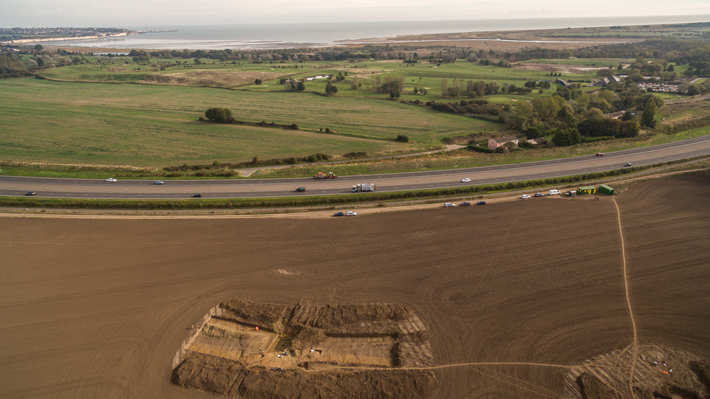
 Almost one hundred years before the Roman Empire conquered Britain, Julius Caesar invaded the island in 55 B.C. and again the following year. The exact locations of his landings have been debated, but recent evidence suggests that one occurred at Ebbsfleet, at the Isle of Thanet in eastern Kent. During construction of a modern road, workers discovered a large ancient ditch measuring around 15 feet wide and six feet deep. Objects found nearby, including Roman weapons, indicated that it was constructed around the middle of the first century B.C., and its size and shape are consistent with Roman defensive networks of that era. Archaeologists believe that Caesar’s army built a temporary fort at the site to protect his fleet of 800 ships. “The wider significance of the discoveries at Ebbsfleet is to refocus attention on the aftermath of Caesar’s invasions,” says University of Leicester archaeologist Andrew Fitzpatrick. “Caesar never intended to stay in Britain,” he adds, “but we theorize that the peace treaty he concluded then paved the way for the eventual invasion and permanent occupation of the Romans in A.D. 43.”
Almost one hundred years before the Roman Empire conquered Britain, Julius Caesar invaded the island in 55 B.C. and again the following year. The exact locations of his landings have been debated, but recent evidence suggests that one occurred at Ebbsfleet, at the Isle of Thanet in eastern Kent. During construction of a modern road, workers discovered a large ancient ditch measuring around 15 feet wide and six feet deep. Objects found nearby, including Roman weapons, indicated that it was constructed around the middle of the first century B.C., and its size and shape are consistent with Roman defensive networks of that era. Archaeologists believe that Caesar’s army built a temporary fort at the site to protect his fleet of 800 ships. “The wider significance of the discoveries at Ebbsfleet is to refocus attention on the aftermath of Caesar’s invasions,” says University of Leicester archaeologist Andrew Fitzpatrick. “Caesar never intended to stay in Britain,” he adds, “but we theorize that the peace treaty he concluded then paved the way for the eventual invasion and permanent occupation of the Romans in A.D. 43.”
Gods of the Galilee
By JARRETT A. LOBELL
Monday, February 12, 2018

While excavating three Byzantine churches in Galilee, archaeologists from Kinneret College on the Sea of Galilee uncovered seven intact mosaic inscriptions that are beginning to fill in the story of small-village life in the fifth century A.D. The inscriptions are in Greek, and by virtue of mistakes in the language, Mordechai Aviam, who directs the project with historian Jacob Ashkenazi, who read the inscriptions, believes that the town and surrounding area was populated during the Roman period by a local Semitic people who were pagans. By the mid-fifth century, they had converted to Christianity. One inscription, one of the longest found to date in western Galilee, gives the names of donors and the names and positions of church officials, including Irenaeus, the bishop of Tyre in 445. “The first importance of these mosaics is that they give us good, dated inscriptions,” Aviam says. They also connect this small, unknown village to the larger Byzantine world.
Another mosaic mentions a woman named Sausann (or Shoshana) as a donor to the church’s construction. This inscription, the first in the region to mention a female donor, “tells us that even in the smallest villages in rural Galilee in the Christian period, women supported ecclesiastical structures and that there were women who had strong personal, social, and financial positions,” says Aviam.

Advertisement
Advertisement
IN THIS ISSUE
From the Trenches
The Mesopotamian Merchant Files
Off the Grid
He’s No Stone Face
Satellites on the Silk Road
Gods of the Galilee
The Venus of Vlakno
Caesar’s English Beachhead
Head in the Sand
Seals of Approval
Early Signs of Empire
Tut’s Mesopotamian Side
Newtonian Whiteboard
Nomadic Chic
Old Woman and the Sea
World Roundup
A rare Neolithic vintage, rock art on the Orinoco, Little Foot the Australopithecus, and medieval bishops’ bachelor pad
Artifact
The early sherd special
Advertisement

Recent Issues
-
 May/June 2024
May/June 2024
-
 March/April 2024
March/April 2024
-
 January/February 2024
January/February 2024
-
 November/December 2023
November/December 2023
-
 September/October 2023
September/October 2023
-
 July/August 2023
July/August 2023
-
 May/June 2023
May/June 2023
-
 March/April 2023
March/April 2023
-
 January/February 2023
January/February 2023
-
 November/December 2022
November/December 2022
-
 September/October 2022
September/October 2022
-
 July/August 2022
July/August 2022
-
 May/June 2022
May/June 2022
-
 March/April 2022
March/April 2022
-
 January/February 2022
January/February 2022
-
 November/December 2021
November/December 2021
-
 September/October 2021
September/October 2021
-
 July/August 2021
July/August 2021
-
 May/June 2021
May/June 2021
-
 March/April 2021
March/April 2021
-
 January/February 2021
January/February 2021
-
 November/December 2020
November/December 2020
-
 September/October 2020
September/October 2020
-
 July/August 2020
July/August 2020
-
 May/June 2020
May/June 2020
-
 March/April 2020
March/April 2020
-
 January/February 2020
January/February 2020
-
 November/December 2019
November/December 2019
-
 September/October 2019
September/October 2019
-
 July/August 2019
July/August 2019
-
 May/June 2019
May/June 2019
-
 March/April 2019
March/April 2019
-
 January/February 2019
January/February 2019
-
 November/December 2018
November/December 2018
-
 September/October 2018
September/October 2018
-
 July/August 2018
July/August 2018
-
 May/June 2018
May/June 2018
-
 March/April 2018
March/April 2018
-
 January/February 2018
January/February 2018
-
 November/December 2017
November/December 2017
-
 September/October 2017
September/October 2017
-
 July/August 2017
July/August 2017
-
 May/June 2017
May/June 2017
-
 March/April 2017
March/April 2017
-
 January/February 2017
January/February 2017
-
 November/December 2016
November/December 2016
-
 September/October 2016
September/October 2016
-
 July/August 2016
July/August 2016
-
 May/June 2016
May/June 2016
-
 March/April 2016
March/April 2016
-
 January/February 2016
January/February 2016
-
 November/December 2015
November/December 2015
-
 September/October 2015
September/October 2015
-
 July/August 2015
July/August 2015
-
 May/June 2015
May/June 2015
-
 March/April 2015
March/April 2015
-
 January/February 2015
January/February 2015
-
 November/December 2014
November/December 2014
-
 September/October 2014
September/October 2014
-
 July/August 2014
July/August 2014
-
 May/June 2014
May/June 2014
-
 March/April 2014
March/April 2014
-
 January/February 2014
January/February 2014
-
 November/December 2013
November/December 2013
-
 September/October 2013
September/October 2013
-
 July/August 2013
July/August 2013
-
 May/June 2013
May/June 2013
-
 March/April 2013
March/April 2013
-
 January/February 2013
January/February 2013
-
 November/December 2012
November/December 2012
-
 September/October 2012
September/October 2012
-
 July/August 2012
July/August 2012
-
 May/June 2012
May/June 2012
-
 March/April 2012
March/April 2012
-
 January/February 2012
January/February 2012
-
 November/December 2011
November/December 2011
-
 September/October 2011
September/October 2011
-
 July/August 2011
July/August 2011
-
 May/June 2011
May/June 2011
-
 March/April 2011
March/April 2011
-
 January/February 2011
January/February 2011
Advertisement






